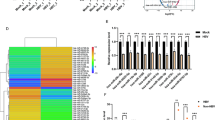Abstract
Occludin (OCLN) is an essential factor for HCV entry through interacting with other surface receptors. The aim of this study was to investigate the epigenetic regulation of Occludin expression and to study its impact on viral infectivity. microRNAs expression was assessed using qRT-PCR, while OCLN protein expression was investigated by indirect immunofluorescence and Western blotting. Viral infectivity was assessed by measuring viral-load using qRT-PCR. In silico analysis predicted that miR-200c targeted the OCLN 3’UTR, which was further experimentally confirmed. miR-122 was previously validated to target the 3’UTR of OCLN and was used as a control. We report a significant down-regulation of miR-200c in liver tissues of HCV-infected patients. Ectopic expression of both miR-122 and miR-200c in Huh7 cells reduced OCLN mRNA and protein levels. Viral infectivity was significantly reduced by miR-200c but enhanced by miR-122. This work sheds light on miR-200c as a novel regulator of HCV infectivity through the regulation of OCLN.






Similar content being viewed by others
Change history
24 March 2018
The author would like to correct the errors in the online published article.
References
Furuse M, Hirase T, Itoh M, Nagafuchi A, Yonemura S, Tsukita S et al (1993) Occludin: a novel integral membrane protein localizing at tight junctions. J Cell Biol 123(6 Pt 2):1777–1788
Cummins PM (2012) Occludin: one protein, many forms. Mol Cell Biol 32(2):242–250. doi:10.1128/MCB.06029-11
Chiba H, Osanai M, Murata M, Kojima T, Sawada N (2008) Transmembrane proteins of tight junctions. Biochim Biophys Acta 1778(3):588–600. doi:10.1016/j.bbamem.2007.08.017
Ploss A, Evans MJ, Gaysinskaya VA, Panis M, You H, de Jong YP et al (2009) Human occludin is a hepatitis C virus entry factor required for infection of mouse cells. Nature 457(7231):882–886. doi:10.1038/nature07684
Brimacombe CL, Grove J, Meredith LW, Hu K, Syder AJ, Flores MV et al (2011) Neutralizing antibody-resistant hepatitis C virus cell-to-cell transmission. J Virol 85(1):596–605. doi:10.1128/JVI.01592-10
Pietschmann T (2009) Virology: final entry key for hepatitis C. Nature 457(7231):797–798. doi:10.1038/457797a
Sourisseau M, Michta ML, Zony C, Israelow B, Hopcraft SE, Narbus CM et al (2013) Temporal analysis of hepatitis C virus cell entry with occludin directed blocking antibodies. PLoS Pathog 9(3):e1003244. doi:10.1371/journal.ppat.1003244
Benedicto I, Molina-Jimenez F, Bartosch B, Cosset FL, Lavillette D, Prieto J et al (2009) The tight junction-associated protein occludin is required for a postbinding step in hepatitis C virus entry and infection. J Virol 83(16):8012–8020. doi:10.1128/JVI.00038-09
Ma J, Yao Y, Wang P, Liu Y, Zhao L, Li Z et al (2014) MiR-181a regulates blood-tumor barrier permeability by targeting Kruppel-like factor 6. J Cereb Blood Flow Metab 34(11):1826–1836. doi:10.1038/jcbfm.2014.152
Ye D, Guo S, Al-Sadi R, Ma TY (2011) MicroRNA regulation of intestinal epithelial tight junction permeability. Gastroenterology 141(4):1323–1333. doi:10.1053/j.gastro.2011.07.005
Sendi H, Mehrab-Mohseni M, Foureau DM, Ghosh S, Walling TL, Steuerwald N et al (2015) MiR-122 decreases HCV entry into hepatocytes through binding to the 3’ UTR of OCLN mRNA. Liver Int 35(4):1315–1323. doi:10.1111/liv.12698
Helle F, Dubuisson J (2008) Hepatitis C virus entry into host cells. Cell Mol Life Sci 65(1):100–112. doi:10.1007/s00018-007-7291-8
Liu S, Yang W, Shen L, Turner JR, Coyne CB, Wang T (2009) Tight junction proteins claudin-1 and occludin control hepatitis C virus entry and are downregulated during infection to prevent superinfection. J Virol 83(4):2011–2014. doi:10.1128/JVI.01888-08
Oliveira KG, Malta FM, Nastri AC, Widman A, Faria PL, Santana RA et al (2016) Increased hepatic expression of miRNA-122 in patients infected with HCV genotype 3. Med Microbiol Immunol 205(2):111–117. doi:10.1007/s00430-015-0431-0
Varnholt H, Drebber U, Schulze F, Wedemeyer I, Schirmacher P, Dienes HP et al (2008) MicroRNA gene expression profile of hepatitis C virus-associated hepatocellular carcinoma. Hepatology 47(4):1223–1232. doi:10.1002/hep.22158
Karakatsanis A, Papaconstantinou I, Gazouli M, Lyberopoulou A, Polymeneas G, Voros D (2013) Expression of microRNAs, miR-21, miR-31, miR-122, miR-145, miR-146a, miR-200c, miR-221, miR-222, and miR-223 in patients with hepatocellular carcinoma or intrahepatic cholangiocarcinoma and its prognostic significance. Mol Carcinog 52(4):297–303. doi:10.1002/mc.21864
Liu Z, Yi J, Ye R, Liu J, Duan Q, Xiao J et al (2015) miR-144 regulates transforming growth factor-beta1 iduced hepatic stellate cell activation in human fibrotic liver. Int J Clin Exp Pathol 8(4):3994–4000
Jopling CL, Yi M, Lancaster AM, Lemon SM, Sarnow P (2005) Modulation of hepatitis C virus RNA abundance by a liver-specific MicroRNA. Science 309(5740):1577–1581. doi:10.1126/science.1113329
Acknowledgements
The authors would like to thank Prof. Jens Bukh and Prof. Wakita for providing us with JFH1 and ED43/JFH1HCV constructs, respectively.
Author information
Authors and Affiliations
Corresponding author
Ethics declarations
Conflict of interest
None.
Additional information
A correction to this article is available online at https://doi.org/10.1007/s00705-018-3798-6.
Rights and permissions
About this article
Cite this article
Elhelw, D.S., Riad, S.E., Shawer, H. et al. Ectopic delivery of miR-200c diminishes hepatitis C virus infectivity through transcriptional and translational repression of Occludin. Arch Virol 162, 3283–3291 (2017). https://doi.org/10.1007/s00705-017-3449-3
Received:
Accepted:
Published:
Issue Date:
DOI: https://doi.org/10.1007/s00705-017-3449-3




